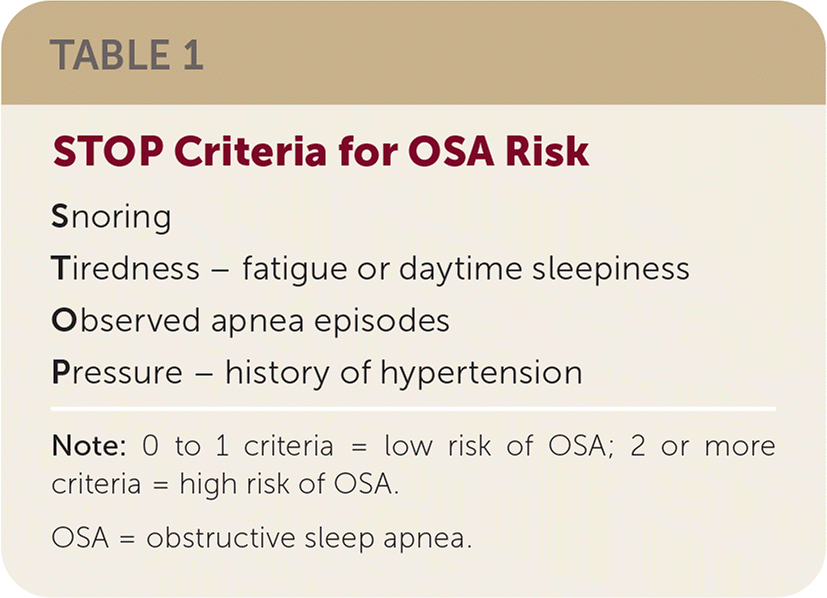
Am Fam Physician. 2021;103(7):442-443
Author disclosure: No relevant financial affiliations.
Key Points for Practice
• The shorter STOP tool for evaluating OSA is easier to administer than the STOP-BANG criteria but equally sensitive.
• PAP is the most effective OSA treatment, although mandibular advancement devices are easier for patients to use.
• The Insomnia Severity Index and Athens Insomnia Scale are useful to grade insomnia before and after treatment.
• CBT is the most effective treatment for chronic insomnia, whereas sleep hygiene education alone is potentially harmful.
From the AFP Editors
Sleep disturbances are common and likely underdiagnosed. Obstructive sleep apnea (OSA) affects up to 38% of U.S. adults, especially men, postmenopausal women, and people with a higher body mass index. Insomnia symptoms affect up to 30% of U.S. adults, with up to 10% meeting criteria for chronic insomnia disorder. The U.S. Department of Veterans Affairs and Department of Defense (VA/DoD) approved a clinical practice guideline for the management of OSA and chronic insomnia disorder.
Diagnosis of OSA
Testing for sleep apnea should be considered based on clinical risk. The STOP and STOP-BANG criteria had the highest sensitivities for OSA screening, but using the shorter STOP tool (Table 1) is recommended because it is easier to administer. People with cardiovascular or cerebrovascular events, congestive heart failure, or long-term opioid use are considered high risk regardless of STOP score, although the evidence behind this recommendation is weak.

| Snoring |
| Tiredness – fatigue or daytime sleepiness |
| Observed apnea episodes |
| Pressure – history of hypertension |
In-laboratory polysomnography is the standard for diagnosing OSA. The diagnosis can also be made using home sleep apnea testing, with an unattended portable monitor. The home sleep apnea test can report the respiratory disturbance index, respiratory event index, or apnea-hypopnea index; 15 or more events per hour on any one index indicates OSA. Patients with a high risk of OSA and negative home sleep apnea test results should receive repeat testing, with home sleep apnea testing or polysomnography.
Treatment of OSA
For patients with OSA, positive airway pressure (PAP) for the entirety of the sleep period is the most studied and only beneficial treatment for severe disease. The effect of PAP on cardiovascular events is unproven. Because many patients struggle with adherence, educational, behavioral, and supportive interventions should be considered to improve use. Less than the recommended four hours per night of PAP use is still beneficial. Mandibular advancement devices are appropriate for mild to moderate OSA and improve adherence. Although PAP is better at reducing apneic and hypopneic episodes, use of a mandibular advancement device results in similar improvement in daytime sleepiness, cognitive function, vigilance, hypertension, and quality of life.
If standard therapy is ineffective, referral to a sleep specialist is warranted. Surgical referral may be helpful if nasal obstruction reduces PAP adherence, or in certain cases of severe OSA with poor PAP adherence where hypoglossal nerve stimulation therapy or maxillomandibular advancement surgery might be helpful. Interventions not recommended include isolated oxygen treatment for patients who cannot tolerate other therapies, as well as topical nasal steroids for the sole purpose of improving PAP adherence.
Assessment of Chronic Insomnia Disorder
Consider medical, substance-related, and psychiatric causes before diagnosing chronic insomnia disorder. Because of the variable symptoms of insomnia, using the Insomnia Severity Index or Athens Insomnia Scale may help grade symptom severity and monitor treatment effects. It is not necessary to repeat diagnostic testing when standard treatment is ineffective.
Treatment of Chronic Insomnia Disorder
Cognitive behavior therapy (CBT) for insomnia is the best treatment for chronic insomnia. CBT for insomnia includes sleep restriction therapy, stimulus control, sleep hygiene education, and relaxation therapy and counterarousal strategies. Sleep hygiene education alone is not effective, and may be harmful if it discourages patients from considering other CBT components. CBT for insomnia has been shown to be more effective than several sleep medications. Internet-based or group CBT can increase access, but effectiveness has not been proven. Brief behavioral treatment for insomnia is a shorter alternative to CBT focusing only on sleep restriction, stimulus control, and sleep hygiene.
Long-term medication is not recommended for chronic insomnia, and many short-term medications have risks of overuse. If medications are required, doxepin or nonbenzodiazepine receptor agonists (e.g., zolpidem [Ambien], zaleplon [Sonata], eszopiclone [Lunesta]) are recommended at the lowest effective dose for the shortest possible duration. Antipsychotics, benzodiazepines, antihistamines, and trazodone are not recommended in chronic insomnia because of adverse effects and limited effectiveness. Neither ramelteon (Rozerem) nor suvorexant (Belsomra) has sufficient evidence to recommend use.
Auricular acupuncture with seed and pellet has weak evidence of benefit without harms, whereas other complementary and integrative health remedies are not beneficial. Melatonin, valerian, and chamomile did not show significant clinical effectiveness, and kava adds the additional risk of liver failure. Nonauricular acupuncture, aerobic exercise, resistive exercise, tai chi, yoga, and qigong have not been well studied in chronic insomnia disorder.
Guideline source: U.S. Department of Veterans Affairs/Department of Defense
Evidence rating system used? Yes
Systematic literature search described? Yes
Guideline developed by participants without relevant financial ties to industry? Yes
Recommendations based on patient-oriented outcomes? Yes
Published synopsis: Ann Intern Med. March 3, 2020;172(5):325–336
Source available at: https://www.healthquality.va.gov/guidelines/CD/insomnia/index.asp
